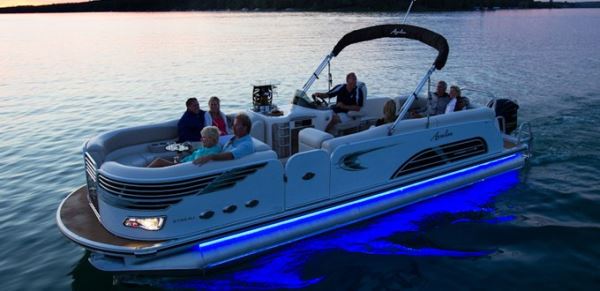.jpg_600.jpg) Who doesn't love a hot new trend? We certainly do. It's something we are always on the lookout for at our annual Shootout Boat Test. One thing that has been taking off lately is outside rub rail lighting that gives your boat a sleek look with blue LED lighting. But before you whip out the checkbook to add some flare to your boat, did you know that it could be considered illegal?
Who doesn't love a hot new trend? We certainly do. It's something we are always on the lookout for at our annual Shootout Boat Test. One thing that has been taking off lately is outside rub rail lighting that gives your boat a sleek look with blue LED lighting. But before you whip out the checkbook to add some flare to your boat, did you know that it could be considered illegal?
I say could be instead of is because as far as I'm concerned it falls into a gray area and, quite frankly, could go either way. I did some calling around and it seems like a lot of different areas around the country have conflicting thoughts.
One reader, Anthony Wilson, from Ardmore, Okla., shared his experience with us.
"I would love to have them on my pontoon because I saw how nice they were out on the water," says Wilson. "But the very first time I saw them our lake patrol stopped the driver and made him turn them off."
Yet others from the Midwest have told us they use them all the time and authorities from their lake don't even look twice.
Requirements
As most of you are probably aware, the U.S. Coast Guard has very specific guidelines on navigation lighting. I would fully outline them here but it's complicated. It depends on the length of your vessel, its overall use and other such things. For the sake of space, I'm going to move forward with the assumption that most of us do our recreational boating in vessels under 39 feet in length.
The requirements are:
.jpg_600.jpg)
1. Masthead Light: a white light placed over the fore and aft centerline of the vessel
2. Side Lights: a green light on the starboard side and a red light on the port side
3. Stern Light: a white light placed as nearly as practicable at the stern
Rule 20(b)
Here's where the tricky part comes into play. This is the official stance from the USCG:
Rule 20(b) The Rules concerning lights shall be complied with from sunset to sunrise, and during such times no other lights shall be exhibited, except such lights which cannot be mistaken for the lights specified in these rules or do not impair their visibility or distinctive character, or interfere with the keeping of a proper look-out.

Now do you see why I'm telling you it's not clear? When it comes down to it, the minimum USCG lighting for a vessel under way at night is the only legal lighting. It says, "no other lights shall be exhibited" then follows it up with a "but" which creates a feeling of compromise. In my opinion, blue LED lights can't be confused with the navigation lights. But if you have brand-new rub rail lights, will they overpower your navigation lights? Maybe.
Finding A New Way
Something I feel that the Coast Guard is overlooking is that while the traditional system may be overpowered by the brand-new lights, is that really a bad thing? It's kind of like saying that other people on the lake can see you too well. Is that even possible? It's not always in the best interest to do things the same way we've always done them when technology continues to advance.
The sad part of this story is that when safety is up in the air, human life is at stake. A 51-year-old woman was killed in Oklahoma when the boat she was riding in was hit by another boat. The driver was not under the influence of alcohol but truly didn't see the boat as he approached it. Witnesses said that because the boat the woman was traveling in was moving parallel with the shore, the navigation lights blended in with the light from the land.
Time For An Update
The red, green and white light system has long been the standard not only in boating, but in aviation as well. This makes sense because like a boat, a plane is not restricted to a road or a track, but moves freely from obvious boundaries. Yet aviation has been more adaptable. Flashing strobe lights have long been added to airplanes to enhance visibility in the sky. When it comes down to being seen or not being seen, planes are doing much better. As a mother of an epileptic child, am I advocating for boats to be equipped with bright strobe lights? Hardly. But is it time for the boating industry to get an update that works for the waterways? Yes.
 More Lights!
More Lights!
It would be better to encourage additional lighting on boats for increased visibility. The fear of washing out the light system is almost unfounded these days. It's very simple. If you are on a lake at night, the very first step to avoiding a collision is to see the other person. Or to have him see you.
Please don't get me wrong. I'm not advocating for anyone to break the law. While I'm very sensitive to our government overstepping their bounds (a quality that my husband used to find endearing while we were dating but now warrants an eye roll) I have to believe the government is trying to act in the best interest of the public. But its time to change boating laws to increase the lighting on the waterway at night for the safety of all. Plus blue rub rail lighting looks really, really cool.

